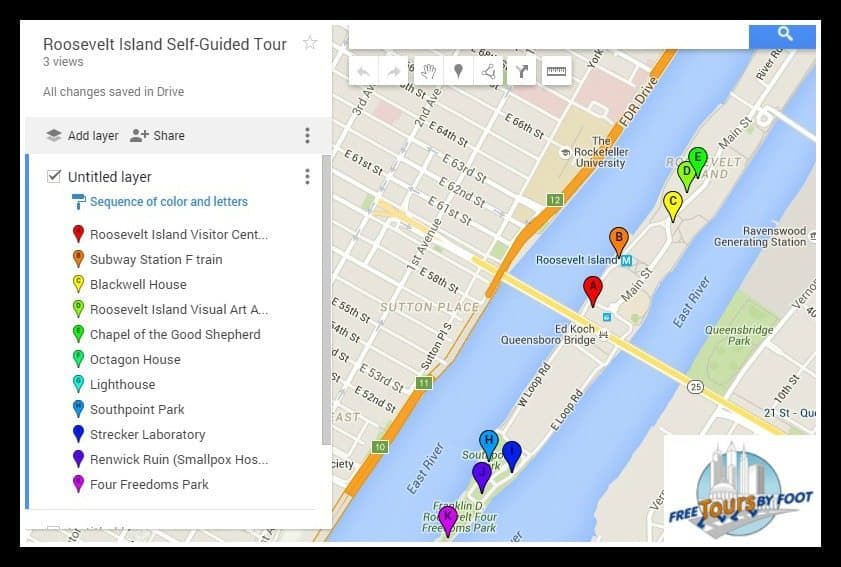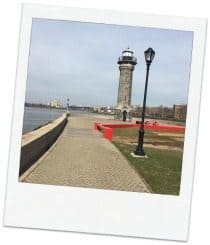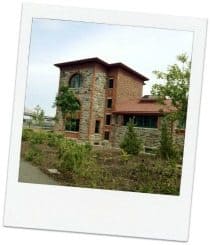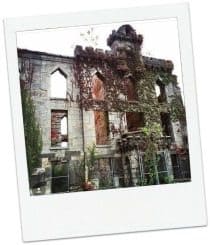This post is a self-guided tour of Roosevelt Island, located in the middle of the East River.
You may recognize the island by the red aerial tram that goes to the island.
The tram has been the setting for many films and TV shows, such as Spider-Man (2002), in which the Green Goblin blows up the Roosevelt Island tram station.
TIP: Check out our other self-guided tours and our GPS-enabled audio tours.
BACKGROUND
Located in the middle of the East River, Roosevelt Island offers picturesque views all the way around its perimeter.
There are also several interesting landmarks ion the island that played noteworthy roles in the City’s history.
The Island is mostly residential -- among some of the Island’s past residents include Kofi Annan, former United Nations Secretary-General, now deceased actor Al Lewis, who played "Grandpa" on The Munsters, and Sarah Jessica Parker, the actress who is best known for her role as Carrie Bradshaw from Sex and the City.
Its appeal to residents is its small-town feel, with many big parks. For visitors, the appeal is, of course, the views as well as the historic, landmarked buildings.
A trip to Roosevelt Island is well worth a visit if you have time in your schedule.
Getting to Roosevelt Island via the tram is easy and part of the fun. If you are afraid of heights, no problem – the subway goes there too.
Crossing the river from 250 feet above, the tram ride is a thrilling 3-minute ride with spectacular views of New York City.
The views from the Island itself are also fantastic. For information on where to go to get other great skyline views, see our post Skyline Views of NYC.
All the details can be found in our detailed instructions on getting to Roosevelt Island.
THINGS TO SEE AND DO ON ROOSEVELT ISLAND
The island is only 2 miles (3.2 km) long and very walkable. From the south to the north, it's the equivalent of 35 city blocks.
Touring the Island will take about 3 hours. It’s best to go when the weather is pleasant as all the sights are outdoors.
If you want to speed up your time between sights, there is a local small red bus costing 25 cents per ride that traverses the island making a north/south loop.
Note that the bus does not go all the way to the tips of the island so you will still need to do a bit of walking to see some of the sites included in our self-guided tour below.
Click here for a larger interactive map.
Roosevelt Island Historical Society Visitor Center
This welcome center adjacent to the tram station was once the kiosk entry for the trolley car service that ran over the Queensboro Bridge to the island from 1930 to 1957 when buses replaced it.
This was long before the aerial tramway was installed in 1976, followed by the F train subway service in 1989.
At the Visitor Center, you can buy souvenirs and historical books about the island and ask any questions of the staff who are volunteers who live on the Island.
Hours: Wednesday-Sunday 12:00 – 5:00 p.m. Closed on Monday & Tuesday. See their website.
Blackwell House
The best place to start your tour of the Island’s landmarks is here - at New York City’s 6th oldest house.
This modest colonial-style house was built in 1796 for the Blackwell family, who owned the island for many generations beginning in 1686.
Fittingly, the island was called Blackwell Island.
In 1828, the City of New York purchased the island for $32,500 (adjusted for inflation, that would be $680,242 in 2016 prices).
The city erected a smallpox hospital, an almshouse (home for the poor), and a penitentiary.
Later, an asylum for the mentally ill was built. In 1921, the City renamed Blackwell Island to the better-suited name of Welfare Island.
Over time the Island’s many institutions ceased to be necessary and one by one they closed down.
In 1971, the Island was renamed Roosevelt Island in honor of former President Franklin D. Roosevelt.
Today Blackwell House has been refurbished and is used as a community center. It is designated a New York City and National landmark.
Roosevelt Island Visual Art Association (RIVAA)
This is a local art association, which supports community efforts to enhance cultural development on the island.
They collaborate with schools for educational events and promote public involvement through the arts.
Musical performances, theatre, dance, book signings and poetry readings by talented professionals and various community gatherings are hosted on a continual basis by Gallery RIVAA.
They also install exhibitions in the historic Octagon lobby (included in this tour). Click here for their calendar of exhibits.
Chapel of the Good Shepherd
Good Shepherd’s historical roots go back to the 19th century when Roosevelt Island was serving as a home for some of the city’s poor, sick, and mentally ill residents.
Beginning around 1850, the Episcopal (Anglican) Church, through its Mission Society, began sending missionaries over to the Island to serve the residents of the almshouses.
n 1872, the Episcopal Church of New York appointed a Chaplain to the Island, but the almshouse officials would not let services be conducted on-site.
A benefactor, George Bliss, stepped forward with funding, and the noted architect Frederic Clark Withers (who designed the landmarked Jefferson Market Courthouse in Greenwich Village) was commissioned to design “the most beautiful church in the city for its most neglected class of humanity.”
The Chapel was completed in 1889.
Over time, the welfare institutions on the Island closed down and in 1952 the almshouses next to the Chapel were closed and converted into two long-term care hospitals.
The Chapel of the Good Shepherd building became the personal residence for the chaplain of one of the hospitals.
In the late 1960s and early ’70s, the island was re-developed as Roosevelt Island, a planned community of mixed-income housing.
The chapel building was deeded to the Roosevelt Island Operating Corporation (RIOC) who renovated it and reopened it as the Roosevelt Island Community Center, where public meetings of all kinds could take place.
At the same time, the Episcopal Church restarted its original mission of serving the residents of the island, now an entirely different type of population made up of mainly middle-income New Yorkers.
Image by Payton Chung (Flickr) [CC BY 2.0], via Wikimedia Commons
The Octagon
In 1839, this building was the main entrance to the New York City Municipal Lunatic Asylum.
This asylum gained an infamous reputation for its horrific treatment of its patients.
In 1887, journalist Nellie Bly faked insanity to expose the horrible conditions at the asylum.
Her book, Ten Days in a Mad-House, led to a grand jury investigation and the hospital was forced to alter its practices and be more humane.
The asylum remained open for several more years before being converted into the Metropolitan Hospital which stayed open until 1955.
The building fell into disrepair and was unused for 50 years.
When the redevelopment of Roosevelt Island began, the asylum’s main wings were torn down but the Octagon was inadvertently left standing and its deterioration continued.
In 2006, it was refashioned as the lobby for the attached high-end residential housing.
Visitors can enter the Octagon to see the building’s original rotunda, framed by a spiral staircase, as well as visit the adjacent gallery with RIVAA exhibits.
No photos are allowed in the Octagon.
The Lighthouse
This Gothic-style lighthouse was built by the City of New York in 1872.
The architect was the famed James Renwick, Jr., who designed St. Patrick’s Cathedral.
Its purpose was to light the way for boats navigating “Hell Gates”, a treacherous part of the East River that lies just north of the tip of the Island.
The Lighthouse was built using stone quarried on the Island and construction was carried out with the use of forced labor provided by the inmates of the Island’s penitentiary.
The lighthouse ceased being used in the 1940s.
Surrounding the lighthouse is a quaint park which is a lovely spot to lay down on a blanket on the grass and enjoy the splendid views of Manhattan and Queens before heading back south.
There are restrooms here as well.
Tom Otterness sculpture "The Marriage of Money and Real Estate"
If you walk from the north point of the island along the western promenade facing Manhattan, you can't miss a group of bronze sculptures placed in the water next to the promenade.
The sculptures, a set of playful, cartoonish figures, were created in 1996 and installed at this location in 2005.
Tom Otterness is the same artist behind the whimsical figures along the platforms of the 14th Street and Eighth Avenue subway station as well as many other public art installations in the city.
The House at Cornell Tech

Completed in 2017, this unusually shaped and stunning building is a 26-story, 352-unit residential high rise that houses about 530 graduate students, faculty, and staff of Cornell University's NYC campus.
What is special about it is that it is considered to be the tallest "Passive House" in the world.
To be able for architects to claim that their building is a 'Passive House', they must receive an official certification that it has met certain strict standards beneficial to the environment, much like the energy-saving LEED certification.
Cornell House uses 60-70 percent less energy than that of a typical building!
The wave of the future is just an 8-minute walk from what is left of the Smallpox Hospital, built in 1856.
Strecker Memorial Laboratory
This now-defunct laboratory was built in 1892 and was the first laboratory in the country devoted exclusively to pathological and bacteriological research.
The lab was closed in the 1950s and the building was unused until in 2000 it was restored by the city to house a substation that has powered the E and M subway lines.
The building is a New York City landmark as well as being listed on the National Register of Historic Places.
Southpoint Park
This is a spacious park with lots of green spaces and flora.
It doesn’t get overcrowded and is a great place to sit and enjoy the magnificent view of the Manhattan skyline.
Public restrooms are located at the entrance and there are water fountains throughout the park to keep you hydrated.
Smallpox Hospital (also known as the “Renwick Ruins”)
Inside of Southpoint Park are the remnants of a smallpox hospital built on the island in 1856.
This site is considered one of NYC's secret gems, though not everyone knows that. This article from Jetline Cruise explains why the Smallpox Hospital ruins are so alluring.
Like The Octagon, architect James Renwick, Jr. designed this Gothic-style hospital building.
It was the first hospital in the United States to take in smallpox patients, the highly contagious and deadly disease.
Although a vaccine existed, it wasn’t until the late 1800's that efforts were made in the United States to eradicate the disease by universal vaccination.
Until then, special hospitals were built specifically for treating smallpox sufferers.
From its opening until its closing in 1875, the hospital treated about 7,000 patients a year.
In 1875, the hospital was moved to North Brothers Island since Blackwell Island was becoming overcrowded and not an appropriate setting for a hospital populated with infectious patients.
The building was then converted into a nurses' dormitory.
But as the institutions and hospitals of Blackwell’s Island (by now renamed Welfare Island) closed down, the hospital building was abandoned in the 1950s and fell into terrible decay and disrepair.
However, in the 1960s, the deteriorating structure was saved by the Landmarks Preservation Commission, who had what was left of the hospital shored up to avoid total collapse.
What little remains of the original building is often referred to as the “Renwick Ruins.”
Overrun with weeds and wild ivy twisting through the brick structure, the ‘ruins’ have the appearance of a medieval castle. At night, it is just downright spooky!
As tempting it may be, do not go into the areas that are off-limits. You may not go into the remains and it is fenced off.
You will be breaking trespassing laws if you do go beyond where you are permitted, as tempting as it may be.
Fortunately noted Urban Explorer Steve Duncan doesn’t mind the risk. Watch his video and see the inside of the Renwick Ruins at night!
Franklin D. Roosevelt Four Freedoms Park
The Island’s southern-most tip is the site of Four Freedoms Park and a memorial to President Franklin D. Roosevelt.
Opened in October 2012, the Park is one of the last works designed by the famed architect Louis I. Kahn.
The park celebrates the four freedoms that Roosevelt spoke of in his 1941 State of the Union speech: freedom of speech, freedom of worship, freedom from want, and freedom from fear.
The park caught some media attention when in 2015, Hillary Clinton held her first rally after announcing her candidacy for president.
The park hosts events April-October, including yoga in the park, reading forums, walking tours, and playgroups for toddlers.
View the park’s calendar for more information. The park has ample green space for picnicking and sunbathing and yet again, taking in the spectacular views.
If you’ve enjoyed this self-guided tour, we have plenty more for you!
Check out our other self-guided tours and our GPS-enabled audio tours.
Of course, you are always welcome to join one of our pay-what-you-wish walking tours!
















